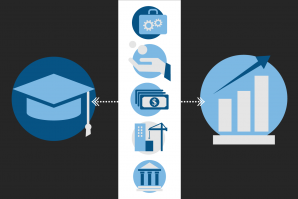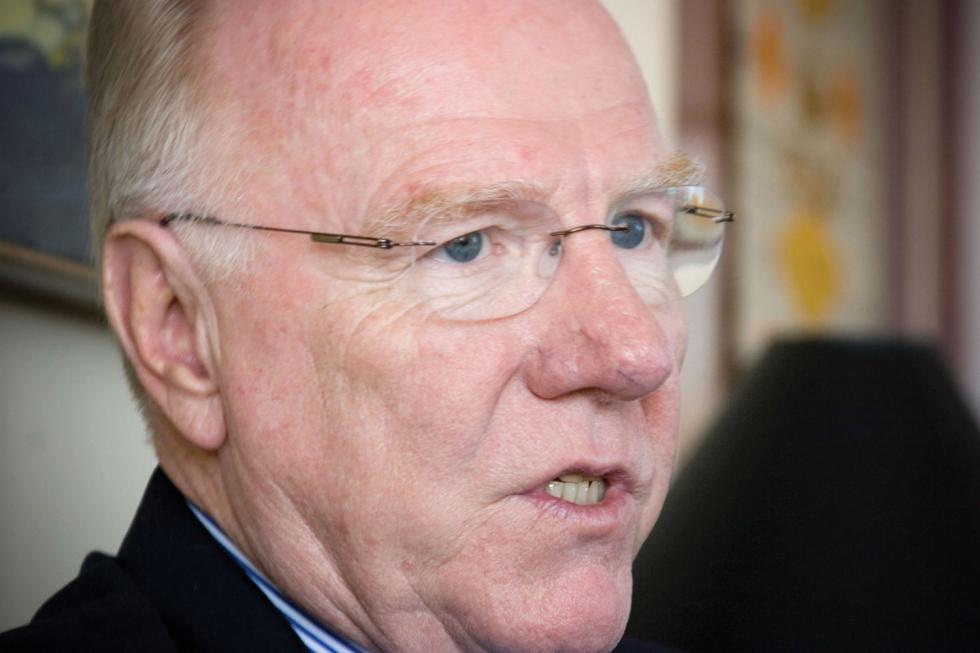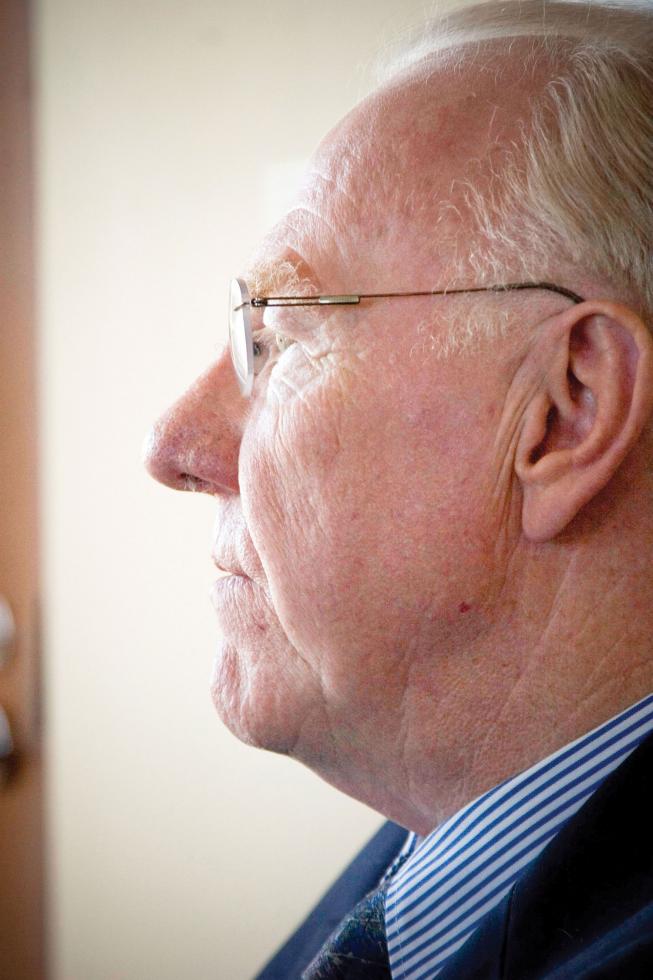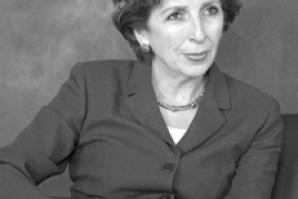After a quarter-century of leadership at UC Davis, Chancellor Larry Vanderhoef will step down. Appointed as UC Davis’ fifth chancellor in 1994, he is one of the nation’s longest-serving university administrators. He came to the campus in 1984, first serving as the executive vice chancellor, and will bow out at the end of the campus’s centennial year on June 30. As part of the celebration, the chancellor sat down with Comstock’s to reflect upon the colorful history of the campus once known as University Farm and the lasting contributions it has on the Capital Region.
After a quarter-century of leadership at UC Davis, Chancellor Larry Vanderhoef will step down. Appointed as UC Davis’ fifth chancellor in 1994, he is one of the nation’s longest-serving university administrators. He came to the campus in 1984, first serving as the executive vice chancellor, and will bow out at the end of the campus’s centennial year on June 30.
To say that UC Davis has grown and prospered on his watch would be putting it mildly. In 1996 the campus was invited to join the prestigious Association of American Universities, representing the top 62 research universities in North America. Research funds, won competitively by faculty, have increased from $169 million to more than $500 million annually. And the campus has seen its national rankings rise. According to Washington Monthly, UC Davis ranks eighth among all U.S. universities in contributions to society. Private gifts have jumped from $40 million to nearly $200 million a year. Cumulatively, more than $1 billion has been raised in support of programs during Vanderhoef’s tenure as chancellor.
Under his guidance, the university has also made great strides in recruiting a diverse and accomplished faculty and student body. Enrollment has grown from 22,000 to 30,000, and the faculty has increased by 44 percent. More than 4 million square feet of classroom, lab, clinical, performance and office space have been added, and the formerly ailing Sacramento County Hospital has been transformed into the state-of-the-art UC Davis Medical Center in the Oak Park neighborhood.
As part of the UC Davis centennial celebration, the chancellor sat down with Comstock’s to reflect upon the colorful history of the campus once known as University Farm and the lasting contributions it has on the Capital Region.
Comstock’s: Let’s revisit the founding of UC Davis. How did
that come about?
Vanderhoef: First, it’s important to note that all 10 UC
campuses are land grant universities. The mission of a land grant
university is to address the needs of society. One hundred years
ago, when UC Davis was established as an agricultural arm of UC
Berkeley, the Berkeley campus was running out of space and there
was a great need for agricultural research. You need to remember,
at that time, nearly 50 percent of the population had either
personally suffered from famine or knew someone who had.
So in the fall of 1908, the new Davis campus opened with 109
students. Initially, it grew very slowly as an agriculture
school. In 1935 the School of Enology & Viticulture was
established. It added the School of Veterinary Medicine in 1948
and the College of Letters and Science in 1951. And then, on the
cusp of the first round of baby boomers graduating from high
school, Davis was named a general campus of the University of
California in 1959. While it was primarily an agriculture school,
leaders at the time felt a great obligation to offer a full range
of programs.
Comstock’s: Why the obligation to offer a full range of
programs?
Vanderhoef: Regents and other leaders throughout the UC
system realized there was a whole new wave of young students
heading to college, and they didn’t all want to be farmers or
teachers or focus on the other specialties that the arm campuses
had been devoted to. What followed was a period of rapid growth
in programs and enrollment for Davis. When I first arrived on
campus in 1984, we had 17,000 students and a full range of
majors. Today, UC Davis is a leader in interdisciplinary study,
offering more than 100 academic majors and 86 graduate programs.
It is the only campus in the UC system with schools of education,
law, management, medicine and veterinary medicine.
Comstock’s: What has this commitment to diversifying
program offerings meant to UC Davis?
Vanderhoef: Well, first and foremost it helps in our
recruiting efforts. We want to attract the best students from
throughout the country and the world to attend UC Davis. And
while there’s nothing wrong with being known as a great
agricultural center of learning, that reputation in itself is a
challenge to overcome when recruiting. Our offerings have made
tremendous strides over the past 25 years. Much of the credit for
this goes to the faculty. They control courses, curriculum and
admission and graduate requirements. Our challenge of overcoming
the reputation of being simply an agriculture school — especially
south of the Tehachapi and east of the Mississippi — may never
end. But obviously we’re making headway; we had more than 50,000
applications last year.
Comstock’s: When you first became chancellor, what goals
did you set for the campus?
Vanderhoef: The university was already blessed with an
incredible studio arts program when I became chancellor. This was
due in no small part to the convergence of planets in the ’60s
when our program included such international rising art stars as
Robert Arneson, Roy De Forest, Manuel Neri, Wayne Thiebaud and
William T. Wiley. I felt this well-deserved reputation as a
center for fine arts needed to be taken one step further. While I
wasn’t the first one to think of it, I made the development of an
arts center a top priority. In my inaugural state-of-the-campus
speech, I stressed the importance of establishing a new face for
the campus within our immediate community and throughout the
region. The development of the Robert and Margrit Mondavi Center
for the Performing Arts in 2002 achieved this goal. While this is
just a building, it really has changed the way people — both on
and off the campus — view UC Davis. Now we’re more than a
university, we’re a regional center for the performing arts. Each
year we have 125,000 people coming to campus to attend events at
the center. We have 40,000 young students attending events.
That’s probably the most significant thing one can witness:
seeing 1,800 fifth- and sixth-graders filling all those seats.
Comstock’s: What role is UC Davis playing in the research
and development of clean, green and alternative energy
technology?
Vanderhoef: We’ve been looking for sometime to build our
buildings better. Very few people know it, but the Tahoe
Environmental Research Center is the first platinum
LEED-certified science building in the country. So we’re
interested in pursuing that kind of building program in the
coming years. The bigger thing is what’s going on in our
programs. The very first experimental research on plug-in hybrids
was conducted on campus. UC Davis and a couple other UC campuses
worked very closely with Toyota in the development of the hybrid
Prius. We continue to work with them in the development of the
hydrogen fuel cell. The work being done within our Institute for
Transportation Studies has drawn national acclaim, including an
appearance on the John Stewart “Daily Show” by the center’s
director, Dan Sperling. They were talking about his recently
published book “Two Billion Cars.” The purpose of the institute
is to figure out what we, as a country, can do about reducing our
massive carbon footprint. We also continue to do a great deal of
[research and development] in energy efficiency and the
conversion of biomass waste into energy. All very exciting stuff,
and all driven by our students and faculty wanting to make this a
better world for future generations.
Comstock’s: As the campus has undergone tremendous growth
in enrollment and facilities, how has UC Davis’ relationship with
the city of Davis changed?
Vanderhoef: It has been an interesting evolution.
Initially, the university and the city were almost one in the
same. In the early days, the City Council and even the mayor were
often university people. As UC Davis grew, the city became a more
attractive place to live because of the quality of life and
amenities offered by the campus. By about the late ’70s, the
number of people living in Davis not associated with UC Davis
became the majority. That’s when things started to change. These
people liked the way the small university town was, and they
didn’t want it to change. Several special interest groups were
formed to resist many of our proposed projects, and lawsuits were
filed. Over time, we learned to work better with these groups,
and we continue to do so. I see the mayor regularly, at least
once a week, to talk about what’s going on. We have established a
very pro-active public relations program to keep everyone in the
know. But the process continues.”
Comstock’s: As your 15-year tenure as chancellor comes to
an end, what do you look back on as your greatest
achievements?
Vanderhoef: If one were to think about physical
accomplishments, I would point to the Mondavi Center for reasons
I explained earlier. Also, I’m quite proud of the entire south
entry expansion project. Then there’s everything we’ve
accomplished with the UC Davis Medical Center in Sacramento. When
I arrived in 1984 that facility was still called a county
hospital. Fortunately, all the surrounding property, which was
once the old state fairground, became available. We now have a
world-renowned academic medical center and at the same time
provide a minimum of $100 million in free medical service to the
uninsured.
In terms of things you can’t grab a hold of, I’m most pleased about the change in people’s attitude and perception of the university. In 25 years this change has been incredibly positive. Attitude is an intangible, but we do have ways of measuring it. Our invitation for membership in the Association of American Universities now puts us in the same conversation with Harvard and the University of Michigan. Another measure is the number of visiting scholars who choose to study at UC Davis. We now rank fourth in the country in that regard. It’s that kind of recognition that will continue to attract the best young minds so that we can continue to carry out our land grant university mission: address the needs of society.
Recommended For You

Growth and Prosperity
UC Davis is the keystone to the Capital Region’s economic success
In civic and business circles, we often hear the lament that Sacramento has never been a corporate headquarters. Many believe this hampers our ability to fully prosper and grow. But, in addition to the attractive traits Sacramento does possess, it has a powerful economic catalyst in its backyard: a top-10 public research university that can be the lifeblood of a stronger, deeper and more resilient regional economy.





